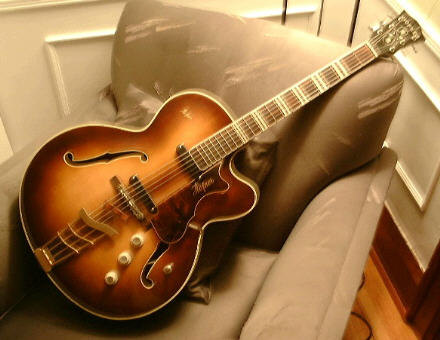


A "Sudbury Hofner", made up from a 1963 Hofner 4550 body, Hofner 456 or 457 neck, "Lyre" tailpiece, late 1950's Hofner pickups, and Gibson Tune-o-Matic bridge.
The "Sudbury Stash" is a group of finished, partially finished, and unfinished archtop guitars and related parts purchased directly from Hofner by luthier and violin dealer Peter Kessler of Canada in the late '80's. Peter was at the old Hofner plant in Bubenreuth on a routine buying trip for luthiery supplies, and happened to be shown a storage room where all of the unsold, unassembled, and factory second stock was mouldering. Carpe diem. He bought it all and shipped it to his shop, Kessler's Violin Shop in Sudbury, Ontario, Canada.
He put together a small b/w catalogue and immediately sold a pile of these guitars. Some had Selmer decals on them, and he sold a dozen or so of these into the UK. He slowly sold off the rest, and is still selling off small bits and pieces on Ebay, although virtually all of the Hofner stuff is gone. Search for "bezdez" on Ebay and you'll find him. His purchase predates the sale of Hofner to Boosey & Hawkes (now The Music Group), and predates the acquisition of the balance of old Hofner parts (spares) by Music Ground in the early '90's.
Approximately fifty of the instruments Kessler purchased were finished or close to being finished. Of the rest, many had finished bodies with unfinished necks. There were also quite a few raw necks, still in need of final carving, with unfretted but slotted fingerboards attached, and unfinished bodies. He also purchased boxes of NOS late-'50's black pups, compensator tailpieces (for thinline and full-depth bodies), tortoiseshell pickguards and cheap-o black plastic bridges with adjustable white plastic pieces.
Peter finished many of the necks and assembled guitars in his own shop. He used the parts that were included in the deal. Tuners were usually nickel-plated Schallers (either keystone-buttoned Kluson/Gibson-style or the metal buttoned older style). Controls were usually three in-line pots (volume/volume/tone) with a three-way switch on the opposite side of the treble f-hole, done up with cheap oriental pots and switches, and Gibson-style speed knobs, either gold or black. Because this control array was never used by Hofner, it is the easiest way to spot a Kessler-assembled Hofner, even if it has had its parts updated or upgraded. Trussrod covers were all Hofner "pear-shaped" covers, a later '60's style still in use on Hofner archtops to this day. Bridges were sometimes rosewood or ebony but most often were the aforementioned tone-sucking black plastic garbage. They're best known for their ability to stain the tops of the guitars on which they are installed.
Kessler often mixed parts on these guitars, using necks and bodies that happened to fit together. This meant that many of the guitars were assembled with mismatched parts. Since most of the parts were of the 449/450/455/456 variety, mixing and matching was not always obvious. Bodies ranged in age from the late '50's right up to the early '70's. Some of his necks had no decals on the headstocks. Some were missing headstock overlays altogether.
I have personally studied over 50 of these instruments and sold many of them. I have also had the pleasure of sorting through the remaining unfinished and unassembled necks and bodies on more than one trip to Sudbury (a town that is most certainly off the beaten track), way back when the internet was just starting up and Ebay was merely an idea. I own a few of these guitars to this day. While those guitars with their tops drilled as described above have only marginal vintage value, they are often great playing instruments, and are perfect platforms for modification or restoration with updated or correct electronics and hardware. As well, some of the guitars were not drilled for controls, and were sold on Ebay as unassembled kits. These instruments can be put together in an historically accurate manner, although I suspect that most of them have probably been the basis for mad guitar experimentation.
Example 1 - Hofner 4550/S/E2 Style
Example 2 - Hofner 450/E2 Style
Example 3 - Hofner Parts
Example 4 - Hofner 456/S/E2 Style
Example 5- Based on Hofner Prototype 450/S All Mahogany Body